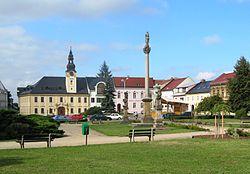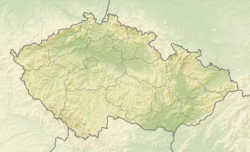Kojetín (Czech pronunciation: [ˈkojɛciːn]) is a town in Přerov District in the Olomouc Region of the Czech Republic. It has about 5,800 inhabitants.
Kojetín | |
|---|---|
 Town square | |
| Coordinates: 49°21′6″N 17°18′8″E / 49.35167°N 17.30222°E | |
| Country | |
| Region | Olomouc |
| District | Přerov |
| First mentioned | 1233 |
| Government | |
| • Mayor | Leoš Ptáček |
| Area | |
• Total | 31.09 km2 (12.00 sq mi) |
| Elevation | 200 m (700 ft) |
| Population (2024-01-01)[1] | |
• Total | 5,790 |
| • Density | 190/km2 (480/sq mi) |
| Time zone | UTC+1 (CET) |
| • Summer (DST) | UTC+2 (CEST) |
| Postal code | 752 01 |
| Website | www |
Administrative parts
editThe town is made up of the town parts and villages of Kojetín I-Město, Kojetín II-Popůvky and Kojetín III-Kovalovice.
Geography
editKojetín is located about 8 kilometres (5 mi) northeast of Kroměříž and 15 km (9 mi) southwest of Přerov. It lies mostly in the Upper Morava Valley, the southern part of the municipal territory is located in the Litenčice Hills. The town is located on the right bank of the Morava River. The Haná River flows south of the town.
History
editAccording to legends, origins of Kojetín can be traced to the times of Samo's Empire. The town is said to receive its name after Samo's legendary son Kojata, who founded a settlement named Kojata, later Kojetín. In fact, it was probably not founded until the 12th or 13th century. The first written mention of Kojetín is from 1233.[2]
Until the Hussite Wars, Kojetín was owned by the Diocese of Prague. After the wars, it was acquired by Jiří of Sternberg. Until the 18th century, it was gradually owned by several aristocratic families. The town achieved the most significant development during the rule of the Pernštejn family. In 1720, it returned to the property of the Diocese of Prague.[2]
Demographics
edit
|
|
| ||||||||||||||||||||||||||||||||||||||||||||||||||||||
| Source: Censuses[3][4] | ||||||||||||||||||||||||||||||||||||||||||||||||||||||||
Transport
editThe D1 motorway from Brno to Ostrava passes through the southern part of the municipal territory.
Kojetín is located on two important railway lines: Brno–Ostrava–Bohumín and Olomouc–Vyškov. A railway line of local importance also leads from Kojetín to Holešov.[5]
Culture
editKojetín lies in the ethnographic region of Haná.
Sights
editThe most important monument and the landmark of the town is the Church of the Assumption of the Virgin Mary. This Baroque church from the end of the 17th century was built on a Gothic ground plan.[2]
The former synagogue in Kojetín is one of the oldest synagogues in Moravia. The building currently serves as a prayer house for the Czechoslovak Hussite Church. There is also a Jewish cemetery, first documented after 1550.[2][6]
Notable people
edit- Jan Tomáš Kuzník (1716–1786), composer and poet; died here
- Beda Dudík (1815–1890), historian
- David Kaufmann (1852–1899), Jewish scholar
- Eduard Hedvicek (1878–1947), Austrian historic personality
- Libor Žůrek (born 1979), footballer
References
edit- ^ "Population of Municipalities – 1 January 2024". Czech Statistical Office. 2024-05-17.
- ^ a b c d "The town of Kojetín". Město Kojetín. Retrieved 2022-02-03.
- ^ "Historický lexikon obcí České republiky 1869–2011" (in Czech). Czech Statistical Office. 2015-12-21.
- ^ "Population Census 2021: Population by sex". Public Database. Czech Statistical Office. 2021-03-27.
- ^ "Detail stanice Kojetín" (in Czech). České dráhy. Retrieved 2023-05-21.
- ^ "Kojetínská synagoga: v základu nejstarší stavba ve městě a jedna z nejstarších synagog na Moravě" (in Czech). Czech Radio. 2019-01-28. Retrieved 2022-02-03.


